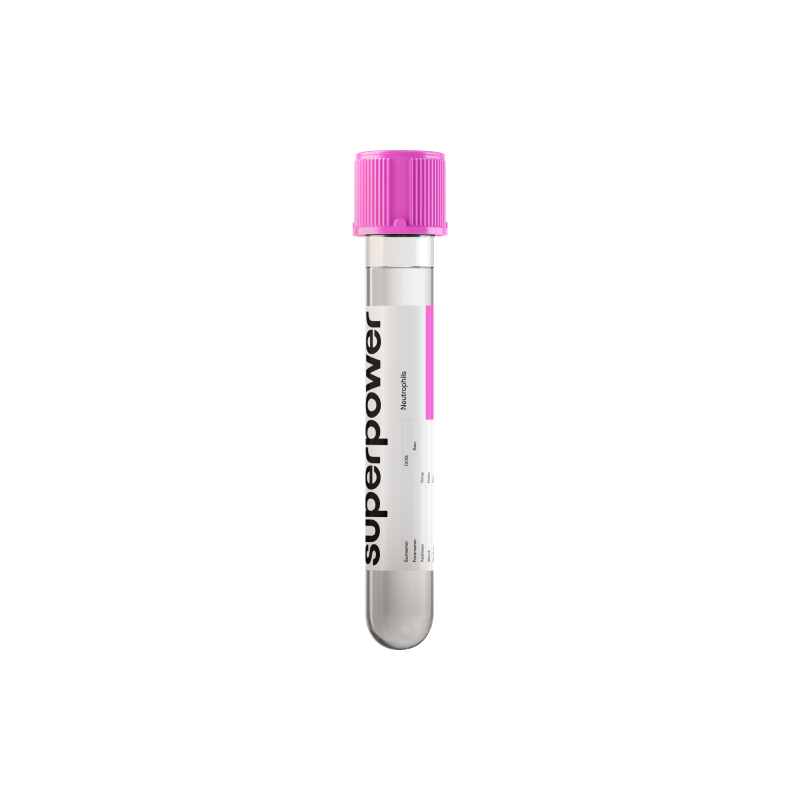Neutrophils are the most abundant white blood cells in circulation and the first responders of your innate immune system. They patrol the bloodstream, exit rapidly into tissues, and neutralize bacteria and fungi through engulfing (phagocytosis), enzyme release, and extracellular antimicrobial traps.
The bone marrow produces them continuously, and they circulate for only hours to a few days before being replaced. During infection, injury, or significant stress, production and release increase to meet demand.
Key Benefits
Check infection-fighting white cells (neutrophils) to assess infection and inflammation status.
- Spot likely bacterial infection or acute inflammation; high neutrophils often rise early.
- Flag low neutrophils that increase infection risk and warrant prompt medical guidance.
- Clarify causes of fever, sore throat, or mouth sores by revealing neutropenia.
- Guide treatment safety by tracking ANC on chemotherapy, immunosuppressants, or clozapine.
- Support pregnancy care by distinguishing normal rises from concerning infection signals.
- Track trends with other CBC markers to detect marrow or nutrient problems.
- Interpret results best as absolute neutrophil count with symptoms and medications.
What is Neutrophils?
Neutrophils are the most abundant white blood cells, made in the bone marrow from myeloid precursors. They are short-lived, circulate in blood, and are kept in a marrow reserve for rapid release. Under the microscope they have a multi‑lobed nucleus and fine granules, which gives them the name polymorphonuclear cells (PMNs). Their granules store potent antimicrobial tools like enzymes and peptides (e.g., myeloperoxidase, elastase, defensins), housed in primary and secondary granules (azurophilic and specific granules). Neutrophils are part of the granulocyte family and the innate immune system.
Their job is rapid front‑line defense against microbes, especially bacteria and fungi. They sense danger signals, move to sites of injury (chemotaxis), engulf invaders (phagocytosis), kill them with reactive oxygen species (respiratory burst) and granule contents (degranulation), and can cast DNA nets to trap pathogens (neutrophil extracellular traps, NETs). By releasing signals (cytokines) they shape early inflammation and call in other immune cells. Neutrophil levels in blood reflect bone marrow output and the body’s immediate immune mobilization.
Why is Neutrophils important?
Neutrophils are the body’s first-responder white cells. They patrol blood and tissues, rapidly engulf microbes and debris. By directing early inflammation and signaling repair, they protect skin, lungs, and gut barriers while coordinating healing across systems.
In adults they typically comprise about 40–70 of white cells, or an absolute count near 1.5–8. Most healthy people sit mid-range. Brief rises with exercise, acute stress, or pregnancy are common and transient.
When neutrophils are low (neutropenia), the innate shield thins. Fewer phagocytes reach mucosal barriers, leading to mouth ulcers, gum soreness, fevers without pus, and skin or lung infections. Gut and urinary defenses weaken. Children may have slightly lower normal ranges during viral illnesses; in pregnancy, low counts are unusual.
When neutrophils are high (neutrophilia), the marrow releases more cells and stress hormones mobilize those on vessel walls. This usually reflects acute bacterial infection, tissue injury, or inflammation, with redness, swelling, pus, or fever. If sustained without clear infection, it can mirror chronic inflammatory load; mild elevation in pregnancy is physiologic.
Big picture: neutrophils knit together innate immunity, inflammation, and repair. Interpreting them with total white cells, lymphocytes, platelets, and CRP clarifies immune tone. Very low levels raise severe infection risk; chronically high levels are linked to higher cardiometabolic and vascular risk over time.
What Insights Will I Get?
Neutrophils measure the circulating frontline white blood cells that locate, ingest, and neutralize microbes and debris. They are a core part of innate immunity and inflammation, influencing how you respond to infection, heal tissue, and signal across metabolic and vascular systems.
Low values usually reflect reduced production in the bone marrow, increased use at infection sites, or immune-mediated destruction. This can follow viral illness, certain medications, nutrient deficits, autoimmune conditions, or an enlarged spleen. Functionally, low counts (neutropenia) weaken rapid defense against bacteria and fungi, raising risk for mouth, skin, and bloodstream infections; the risk rises as counts drop further. Children can have different normal patterns, and pregnancy typically does not lower neutrophils.
Being in range suggests adequate marrow output, a healthy reserve, and balanced innate immune activity. It implies you can mount and resolve inflammatory responses without excessive collateral tissue injury. In most adults, optimal tends to sit in the mid portion of the reference range, though healthy pregnancy often tracks higher within normal.
High values usually reflect acute inflammation or physiologic stress, such as bacterial infection, tissue injury, surgery, myocardial infarction, or corticosteroid exposure, which can shift cells from vessel walls into circulation (demargination). Persistent elevations (neutrophilia) may indicate ongoing inflammatory disease, chronic infection, or, less commonly, a myeloproliferative process.
Notes: Results vary with time of day, recent exercise, stress, pregnancy (often higher), and medications (steroids, growth factors, chemotherapy). Absolute count is more informative than percentage. Reference ranges differ by lab and age. Some populations have benign constitutional low counts (Duffy-null/“benign ethnic neutropenia”).



.svg)



.png)
.png)
.png)
.png)








